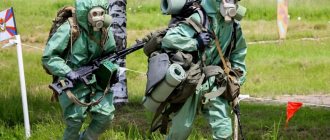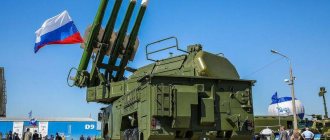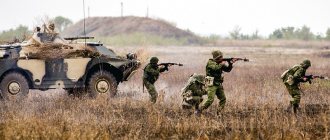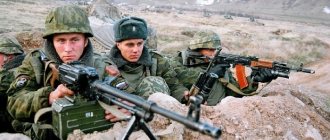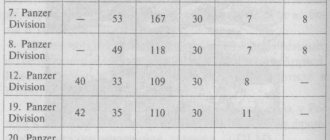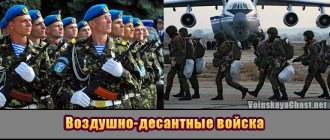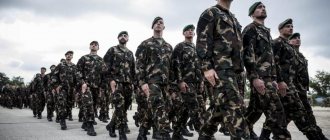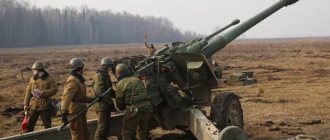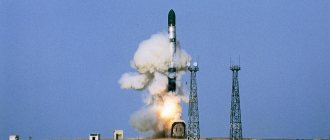The structure of the Armed Forces of the Russian Federation was developed in accordance with the political situation that has developed in the world after the collapse of the Soviet Union and in connection with newly emerging challenges and threats. It is designed to ensure the effectiveness of the combat use of armed forces while significantly simplifying the interaction of various types of armed forces and improving the command and control system.
A three-type structure has been adopted, including the following components:
- ground troops;
- aerospace forces;
- Navy.
There are two separate types of troops:
- strategic missile forces;
- airborne troops.
The armed forces also include:
- rear of the armed forces;
- Housing and Arrangement Service of the Ministry of Defense of the Russian Federation;
- railway troops;
- Main Military Medical Directorate;
- troops not included in the branches of the armed forces.
What are special forces?
Special troops in the armed forces of the Russian Federation include:
- Corps
of Engineers ; - Troops
(RCHBZ); - Corps
; - troops
(EW);
Information Operations Troops- Rear of the Armed Forces: Railway Troops
(ZDV);
Automotive Troops
(AV);
Road Troops
(DV);
Ground troops
As the name suggests, ground forces are designed to conduct combat operations primarily on land. In the history of the Russian state, these troops have always played a vital and often decisive role in achieving victory over the enemy and protecting national interests.
The Ground Forces of the Russian Federation consist of the main branches of the military, special troops and logistics institutions. The main branches of the military are tank, motorized rifle, missile and artillery troops, air defense troops, reconnaissance formations and military units, radiation and chemical protection engineering troops, as well as communications troops.
Tank forces
Tank troops represent the main striking force of the ground forces. They have great firepower, high maneuverability and are better protected from weapons of mass destruction than other types of troops.
Tank troops are used primarily in conjunction with motorized rifle troops in the main axes and perform the following tasks:
- in defense - direct support of motorized rifle troops when repelling an enemy offensive and launching counterattacks and counterstrikes;
- in the offensive - delivering powerful cutting strikes to great depth, developing success, defeating the enemy in oncoming battles and battles.
Motorized rifle troops
Motorized rifle troops are the most massive branch of the military.
They work closely with tank forces and perform the following tasks:
- in defense - holding occupied areas, lines and positions, repelling enemy attacks and defeating his advancing groups;
- in an offensive (counter-offensive) - breaking through the enemy’s defenses, defeating groupings of his troops, capturing important areas, lines and objects, crossing water barriers, pursuing a retreating enemy;
- conducting oncoming battles and battles, operating as part of naval and tactical airborne assault forces.
Rocket Forces and Artillery
Rocket forces and artillery form the basis of the firepower of ground forces.
Formations, units and subunits of this type of troops are designed to perform the following main tasks:
- gaining and maintaining fire superiority over the enemy;
- defeat of its nuclear attack means, manpower, weapons, military and special equipment;
- disorganization of systems for command and control of troops and weapons, reconnaissance and electronic warfare;
- destruction of long-term defensive structures and other infrastructure;
- disruption of operational and military logistics;
- weakening and isolating the enemy's second echelons and reserves;
- destruction of enemy tanks and other armored vehicles that have penetrated into the depths of the defense;
- covering open flanks and joints;
- participation in the destruction of enemy air and sea landings;
- remote mining of terrain and objects;
- lighting support for night operations of troops;
- smoke, blinding enemy targets;
- distribution of propaganda materials, etc.
Ground Forces Air Defense Forces
This branch of the military is intended to cover troops and objects from the actions of enemy air attacks during combined-arms formations and formations of operations, regrouping and positioning on the spot.
They are responsible for the following main tasks:
- carrying out combat duty in air defense;
- conducting reconnaissance of enemy air and alerting covered troops;
- destruction of enemy air attack weapons in flight;
- participation in the conduct of missile defense in theaters of military operations.
Intelligence units and military units
Reconnaissance formations and military units belong to the special forces of the ground forces and are designed to perform a wide range of tasks in order to provide commanders (commanders) and headquarters with information about the enemy, the state of the terrain and weather in order to make the most rational decisions for an operation (battle) and prevent surprise in enemy actions .
In preparation for and during the conduct of combined arms operations (combat operations), they perform the following main tasks:
- revealing the enemy's plan, his immediate preparation for aggression and preventing the surprise of an attack;
- identifying the combat strength, position, grouping, condition and capabilities of the enemy troops (forces) and its command and control system;
- opening objects (targets) for destruction and determining their location (coordinates);
- opening elements of theater operational equipment, terrain engineering equipment and obstacle systems;
- establishing the degree of terrain passability, the state of communications, the nature of water barriers, the boundaries and sizes of areas of destruction, fires and floods, contamination zones, possible directions for overcoming and bypassing them;
- identification of new means of armed warfare and methods of conducting combat operations used by the enemy, as well as measures taken by him to comprehensively support the operation (combat);
- determination of the moral and psychological state of enemy troops and the local population, the economic state of the area of operation (combat operations), etc.
Corps of Engineers
Engineer troops are special troops designed to perform the most complex tasks of engineering support for combined arms operations (combat operations), requiring special training of personnel and the use of engineering weapons, as well as to inflict losses on the enemy through the use of engineer ammunition.
When preparing and conducting combined arms operations (combat operations), engineering troops perform the following main tasks:
- engineering reconnaissance of the enemy, terrain and objects;
- construction (arrangement) of fortifications (trenches, trenches and communication passages, shelters, dugouts, shelters, etc.) and arrangement of field structures (residential, economic, medical) for the deployment of troops;
- installation of engineering barriers, including the installation of minefields, blasting operations, installation of non-explosive barriers (anti-tank ditches, scarps, counter-scarps, gouges, etc.);
- demining of terrain and objects;
- preparation and maintenance of troop movement routes;
- equipment and maintenance of crossings on water barriers, including the construction of bridges;
- extraction and purification of water in the field, etc.
Radiation and chemical protection troops
Radiation, chemical and biological protection troops (RCBZ) are special troops designed to carry out a complex of the most complex measures aimed at reducing losses of formations and formations of ground forces and ensuring the fulfillment of combat missions assigned to them when operating in conditions of radioactive, chemical and biological contamination, and also to increase their survivability and protection from precision and other types of weapons.
Read: 1st Guards Motorized Rifle Division
RCBZ troops perform the following tasks:
- identification and assessment of the radiation, chemical and biological situation, the scale and consequences of destruction of radiation, chemical and biologically hazardous objects;
- ensuring the protection of compounds and parts from the damaging factors of weapons of mass destruction and radiation, chemical, biological contamination;
- reducing the visibility of troops and objects;
- liquidation of consequences of accidents (destructions) at radiation, chemically and biologically hazardous facilities;
- inflicting losses on the enemy using flamethrower and incendiary weapons.
Signal Corps
Signal troops are classified as mixed troops. They are designed to deploy a communications system and provide command and control of formations, formations and units of ground forces in peacetime and wartime. They are also tasked with operating systems and automation equipment at control points.
Division
The main operational-tactical formation. Just like a regiment, it is named after the predominant branch of troops in it. However, the predominance of one or another type of troops is much less than in the regiment. A motorized rifle division and a tank division are identical in structure, with the only difference being that in a motorized rifle division there are two or three motorized rifle regiments and one tank, and in a tank division, on the contrary, there are two or three tank regiments and one motorized rifle. In addition to these main regiments, the division has one or two artillery regiments, one anti-aircraft missile regiment, a rocket battalion, a missile battalion, a helicopter squadron, an engineer battalion, a communications battalion, an automobile battalion, a reconnaissance battalion, an electronic warfare battalion, and a logistics battalion. a repair and restoration battalion, a medical battalion, a chemical defense company, and several different support companies and platoons. In the modern Russian Army, there are or may be divisions of tank, motorized rifle, artillery, airborne, missile and aviation divisions. In other branches of the military, as a rule, the highest formation is a regiment or brigade. On average, there are 12-24 thousand people in a division. Division commander, Major General.
Part (V.ch.)
It is the basic unit of the armed forces. The term “unit” most often means regiment and brigade. The external features of the unit are: the presence of its own office work, military economy, bank account, postal and telegraph address, its own official seal, the commander’s right to give written orders, open (Military Unit 08728) and closed (44 tank training division) name. That is, the part has sufficient autonomy. The presence of a Battle Banner is not necessary for a unit. In addition to the regiment and brigade, the units include division headquarters, corps headquarters, army headquarters, district headquarters, as well as other military organizations (voentorg, army hospital, garrison clinic, district food warehouse, district song and dance ensemble, garrison officers' house, garrison household goods services, central school for junior specialists, military school, military institute, etc.). In a number of cases, the status of a unit with all its external signs may be the formations that we classified above as subdivisions. Units can be a battalion, a company, and sometimes even a platoon. Such formations are not part of regiments or brigades, but directly as an independent military unit with the rights of a regiment or brigade can be part of both a division and a corps, army, front (district) and even directly subordinate to the General Staff. Such formations also have their own open and closed names. For example, the 650th separate airborne transport battalion, the 1257th separate communications company, the 65th separate radio reconnaissance platoon. A characteristic feature of such parts is the word “separate”, which appears after the numbers before the name. However, a regiment can also have the word “separate” in its name. This is the case if the regiment is not part of the division, but is directly part of the army (corps, district, front). For example, the 120th separate regiment of guards mortars.
- Note 3 : Please note that the terms military unit (V.ch.) and military unit (V/Ch No.) do not mean the same thing. The term “military unit” is used as a general designation, without specifics. If we are talking about a specific regiment, brigade, etc., then the term “military unit” is used. Usually its number is also mentioned: “military unit 74292” (but you cannot use “military unit 74292”) or, in short, military unit 74292.
What types of troops are included in the Ground Forces?
- Motorized rifle troops
- Tank forces
- Rocket Forces and Artillery
- Air defense troops
- Intelligence units and military units
- Corps of Engineers
- Signal Corps
Interesting materials:
In what year was Ekaterina Andreeva born? In what year was Masha Ilyukhina born? In what year was Nadezhda Babkina born? In what year was Nelly Uvarova born? In what year was Nina Doroshina born? In what year was the singer Jasmine born? In what year was Svetlana Alliluyeva born? In what year was Umaturman born? In what year were Taurus born? In what year were the fewest children born in Russia?
Brigade
Just like a regiment, it is the main tactical formation. Actually, the brigade occupies an intermediate position between a regiment and a division. The structure of a brigade is most often the same as a regiment, but there are significantly more battalions and other units in a brigade. So in a motorized rifle brigade there are one and a half to two times more motorized rifle and tank battalions than in a regiment. A brigade can also consist of two regiments, plus battalions and auxiliary companies. On average, the brigade has from 2 to 8 thousand people. The brigade commander, as well as the regiment, is a colonel.
Army
This word is used in three main meanings: 1. Army - the armed forces of the state as a whole; 2. Army - ground forces of the armed forces of the state (as opposed to the fleet and military aviation); 3.Army - military formation. Here we are talking about the army as a military formation. The army is a large military formation for operational purposes. The army includes divisions, regiments, battalions of all types of troops. Armies are usually no longer divided by branch of service, although tank armies may exist where tank divisions predominate. An army may also include one or more corps. It is impossible to talk about the structure and size of the army, because as many armies exist or existed, so many of their structures existed. The soldier at the head of the army is no longer called “commander”, but “commander of the army.” Usually the regular rank of army commander is colonel general. In peacetime, armies are rarely organized as military formations. Usually divisions, regiments, and battalions are directly included in the district.
Branch
In the Soviet and Russian armies, a squad is the smallest military formation with a full-time commander. The squad is commanded by a junior sergeant or sergeant. Usually there are 9-13 people in a motorized rifle squad. In departments of other branches of the military, the number of personnel in the department ranges from 3 to 15 people. In some branches of the military the branch is called differently. In artillery there is a crew, in tank forces there is a crew. In some other armies, the squad is not the smallest formation. For example, in the US Army, the smallest formation is a group, and a squad consists of two groups. But basically, in most armies, the squad is the smallest formation. Typically, a squad is part of a platoon, but can exist outside of a platoon. For example, the reconnaissance diving section of an engineer battalion is not part of any of the battalion’s platoons, but is directly subordinate to the battalion chief of staff.
Frame
Just as a brigade is an intermediate formation between a regiment and a division, so a corps is an intermediate formation between a division and an army. The corps is already a combined arms formation, that is, it usually lacks the characteristic of one type of force, although there may also be tank or artillery corps, that is, corps with a complete predominance of tank or artillery divisions. The combined arms corps is usually referred to as the "army corps". There is no single structure of buildings. Each time a corps is formed based on a specific military or military-political situation and may consist of two or three divisions and a varying number of formations of other branches of the military. Usually a corps is created where it is not practical to create an army. In peacetime, there were literally three to five corps in the Soviet Army. During the Great Patriotic War, corps were usually created either for an offensive in a secondary direction, an offensive in a zone where it was impossible to deploy an army, or, conversely, for concentrating forces in the main direction (tank corps). Very often then the corps existed for a few weeks or months and was disbanded upon completion of the task. It is impossible to talk about the structure and strength of the corps, because as many corps exist or existed, so many of their structures existed. Corps commander, Lieutenant General.
Company
Several platoons make up a company. In addition, a company may also include several independent squads that are not included in any of the platoons. For example, a motorized rifle company has three motorized rifle platoons, a machine gun squad, and an anti-tank squad. Typically a company consists of 2-4 platoons, sometimes more platoons. A company is the smallest formation of tactical importance, that is, a formation capable of independently performing small tactical tasks on the battlefield. The company commander is a captain. On average, the size of a company can be from 70 to 200 people. Motorized rifle companies usually have about 101-150 people, tank companies 30-35 people. Usually a company is part of a battalion, but it is not uncommon for companies to exist as independent formations. In artillery, a formation of this type is called a battery; in cavalry, a squadron.
